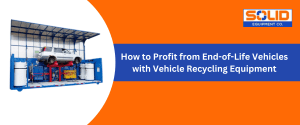What Are End-Of-Life Vehicles?
End-of-life vehicles (ELVs) are cars and trucks that have reached the end of their usable life due to age, damage, or costly repairs. Instead of letting these vehicles sit in a field or head straight to landfill, salvage yards turns them into valuable resources.
An ELV contains:
- Scrap metal (steel, aluminum, copper)
- Reusable auto parts (engines, transmissions, wheels)
- Specialized components like catalytic converters and batteries
- Plastics, glass, and fluids that can be recovered or disposed of safely
By using modern vehicle recycling equipment, scrap yards and auto dismantlers can unlock multiple profit streams while meeting strict sustainability regulations.
How Does Vehicle Recycling Make Money?
The vehicle dismantling and recycling process creates value at every stage:
Dismantling & Depollution
Using vehicle drainage systems, fuel extraction tools, and airbag deployment equipment, recyclers remove hazardous materials like fuel, oil, coolant, and airbags. This step ensures compliance and makes further processing safe.
Parts Salvage & Resale
Quality used parts—engines, transmissions, alternators, wheels—can be cleaned, tested, and resold. Even simple tools like the wheel lug lock buster make part recovery more efficient.
Scrap Metal Recovery
With shears, dismantlers, and shredders, auto scrap recyclers extract large volumes of steel and non-ferrous metals for resale in the scrap metal recycling market.
Specialty Material Recycling
- Catalytic converters yield valuable precious metals.
- Aluminum/Steel rims can be popped off using the wheel rim popper.
- Plastics and wiring can be separated for additional revenue.
Each of these streams adds to the bottom line, making scrapping old cars a highly profitable venture when done with the right equipment.
What Equipment is Used to Recycle Cars?
Modern auto recycling machines streamline every stage of the process. Key categories include:
| Stage | Equipment | Purpose |
| Depollution | Car depollution equipment, A/C removal, airbag deployment | Safely remove fluids, gases, and explosives |
| Dismantling | Auto dismantling equipment | Recover engines, transmissions, and reusable parts |
| Processing | Crushers, balers, auto shears | Compress and prepare scrap for resale |
| Material Separation | Shredders, separators | Extract ferrous and non-ferrous metals, plastics, and glass |
What Parts of a Vehicle Can Be Recycled for Profit?
- Engines & transmissions – resold for reuse
- Catalytic converters – contain platinum, palladium, and rhodium
- Steel & aluminum – key markets for automotive scrap metal recycling
- Copper wiring & electronics – recovered for commercial metal recycling
- Rims & wheels – processed using specialized tools
- Plastics & glass – sold to secondary recyclers
A single scrap vehicle can generate thousands in parts and materials when handled correctly.
Economic and Environmental Benefits of Vehicles Recycling
- Profitability: Each car creates multiple revenue streams from parts resale, metals, and specialty materials.
- Regulatory compliance: Meeting recycling targets is critical for European auto dismantlers, U.S. scrap yards, and global facilities.
- Sustainability: Prevents toxic materials from entering landfills and reduces the demand for new raw materials.
- Reputation: Businesses showcasing eco-friendly scrap vehicle recycling practices attract new customers and contracts.
How to Choose the Right Vehicle Recycling Equipment
Selecting the best car recycling equipment depends on:
- Business size: Smaller yards may start with portable mobile dismantling containers; larger operations need high-throughput shredders and balers.
- Throughput goals: Estimate how many ELVs per day you want to process.
- ROI potential: Look at savings from labor reduction, resale value of salvaged parts, and higher yields from scrap metal auto recycling.
- Specialty needs: Consider add-ons like vehicle depollution equipment or auto dismantling tools based on your focus.
Investing in high-quality vehicle recycling equipment is not a cost—it’s a pathway to maximizing profits, staying compliant, and building a sustainable recycling business.

